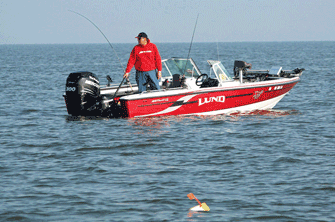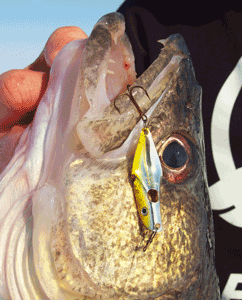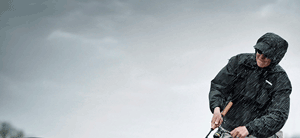Fishing Article Slow Trolling Walleye Tactics - Mitch Eeagan with Mark Brumbaugh
 Walleye Pro Mark Brumbaugh trolls big water after ice-out from his Lund fiberglass Pro-V. Water temperatures are slower to rise than the air temperatures, so even if it’s warm and sunny, bear in mind that cooler lake temps call for slower presentations. Photo courtesy of Lund Boats |
High and Slow Amongst the Flows - Lure selection, speed and positon in-the-water-column dictate early-spring walleye results - By Mitch EeaganPost thaw... It’s unquestionably the most epic time of transformation among the Ice Belt states and provinces. Water temperatures are on the rise, but not nearly as rapidly as the air. Luckily, it only takes a one degree increase in water temp to wake up lethargic walleyes.So why do some anglers motor back to the launch with a livewell full of fish while others return empty netted? Oftentimes, it boils down to trolling speed; using lures that can achieve peak performance at low speeds; and holding those baits in a relatively shallow strike zone. Few on God’s green earth are more adept at trolling for walleyes than Mark Brumbaugh. Since his budding teenage years, the Arcanum, Ohio angler has called the vastness of Lake Erie home. An accredited professional competitor, Brumbaugh has taken top honors in tournaments on some of the biggest bodies of water in North America. And trolling has been his top technique for nearly every one. |
Spoony Tunes
Although they are known to excel later in the season, one lure that doesn’t get fished enough in early-spring is the spoon; this is because most spoons have to be trolled faster than 1 MPH to achieve the proper wobble.
One spoon, however, that excels at slow speeds is Keweenaw Tackle Company’s Fin-Wing. Like a flat-sided bodybait, the Fin-Wing has, well, “wings,” which keep it riding high in the water column at slow speeds, not to mention igniting amazing flash.
One old-school tip for getting any spoon down just under the surface is to attach a 1/4- to 1/2-ounce rubber-core sinker about 8 to 10 feet in front of the lure. The weight will not damage light line like split-shot or snap weights, either.
Although they are known to excel later in the season, one lure that doesn’t get fished enough in early-spring is the spoon; this is because most spoons have to be trolled faster than 1 MPH to achieve the proper wobble.
One spoon, however, that excels at slow speeds is Keweenaw Tackle Company’s Fin-Wing. Like a flat-sided bodybait, the Fin-Wing has, well, “wings,” which keep it riding high in the water column at slow speeds, not to mention igniting amazing flash.
One old-school tip for getting any spoon down just under the surface is to attach a 1/4- to 1/2-ounce rubber-core sinker about 8 to 10 feet in front of the lure. The weight will not damage light line like split-shot or snap weights, either.
Slow, Slow, Slow Your Boat
Looking to land more walleyes than ever at ice out? Just slow it down.
Trolling is the best way to cover a lot of water in a short period of time, and when you do, fish near walleye spawning grounds. Be sure to troll at less than one mile-per-hour and use lures that wobble-well.
Mitch Eeagan is an outdoor writer and photographer who lives in within the cedar swamps in the heart of Michigan’s Upper Peninsula. *Article provided courtesy Traditions Media, used with permission.
Recent Articles and Highlights
The Fishrapper, Fishing Blue Books, LLC - 44076 Co Rd 128, Deer River, MN 56636
218-246-2375 copyright©2016 Fishing Blue Books, LLC All Rights Reserved - last revised 01/05/2017
Current Fishing Reports • Current Video • Fishing Articles • Links • Contact

